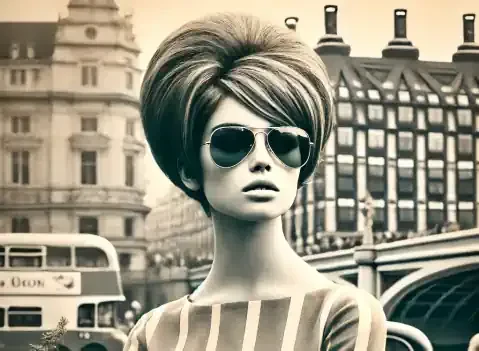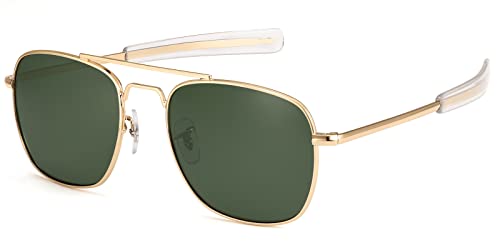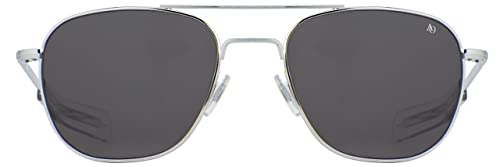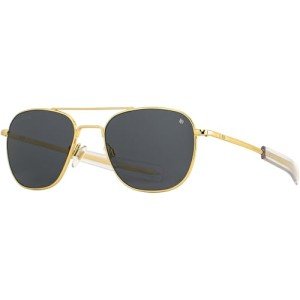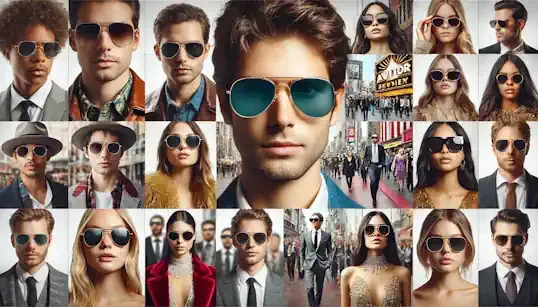Military Origins: The Birth Of Legendary Aviator Sunglasses
In the annals of eyewear history, few styles have soared as high or as enduringly as the aviator sunglasses. Their journey began not on the faces of Hollywood stars or fashion icons, but in the cockpits of military aircraft, where functionality reigned supreme over fashion. Early aviators took to the skies in open-cockpit planes, facing the blinding glare of the sun at high altitudes. Goggles were the initial solution, but they proved cumbersome and limited visibility. A more elegant and effective solution was needed. Enter the aviator sunglasses, designed specifically to address the unique needs of pilots. The large, teardrop-shaped lenses provided maximum coverage, protecting the eyes from sunlight and wind. The thin, lightweight frames ensured comfort during long flights, while the flexible nose pads offered a secure fit even under the force of G-forces. These early aviators were all about utility, with aesthetics taking a backseat to performance.
The turning point for aviator sunglasses came in 1936, when the U.S. Army Air Corps officially adopted a model created by Bausch & Lomb. Dubbed the "Anti-Glare," these sunglasses featured green-tinted lenses designed to reduce glare while enhancing contrast. The iconic teardrop shape remained, providing the optimal field of vision for pilots. This military endorsement catapulted aviators into the mainstream consciousness, associating them with heroism, adventure, and cutting-edge technology.
The outbreak of World War II further solidified the aviator's status as a symbol of valor and heroism. Images of daring fighter pilots sporting their signature sunglasses graced newspapers and magazines, inspiring a nation at war. General Douglas MacArthur, with his corncob pipe and aviators, became an iconic figure, his image etched into the collective memory. The aviator sunglasses, once a specialized tool for pilots, had become a powerful symbol of American bravery and resilience.
As the war ended and soldiers returned home, they brought their aviator sunglasses with them, sparking a surge in popularity among civilians. The sunglasses, once associated with military prowess, became a fashion statement, a symbol of the adventurous spirit and the allure of flight. Brands like Ray-Ban capitalized on this trend, introducing new styles and variations of the classic aviator design. The iconic "Ray-Ban Aviator" became a cultural phenomenon, embraced by men and women alike. The aviator sunglasses had transcended their military origins, soaring into the realm of popular culture, where they would continue to evolve and captivate generations to come.
Hollywood Takes Flight: Aviators On The Silver Screen
The post-war era saw aviator sunglasses make a dramatic transition from military gear to a symbol of Hollywood glamour and cool. Their rise to fame on the silver screen is a testament to their timeless appeal and ability to enhance the charisma of their wearers. One of the most iconic moments in aviator history came in 1986 with the release of Top Gun. Tom Cruise, as the rebellious pilot Maverick, sported a pair of Ray-Ban Aviator 3025 sunglasses, instantly making them the must-have accessory for a generation. The film's soundtrack, featuring Kenny Loggins' "Danger Zone," further cemented the association between aviators and adrenaline-fueled adventure.
But long before Maverick took to the skies, another Hollywood icon had already established the aviator as a symbol of effortless cool. Steve McQueen, known as the "King of Cool," was rarely seen without his signature Persol 714 sunglasses. He wore them in films like "The Thomas Crown Affair" and "Bullitt," solidifying their status as a symbol of sophisticated masculinity. McQueen's effortless style and rebellious spirit perfectly embodied the aviator's allure, making them a coveted item for men who aspired to his level of coolness.
Beyond these two iconic figures, countless other films have featured aviator sunglasses as part of their characters' personas. From Robert De Niro's Travis Bickle in "Taxi Driver" to Daniel Craig's James Bond in "Casino Royale," aviators have graced the faces of some of cinema's most memorable characters. Their presence on screen has not only added to the characters' visual appeal but has also reinforced the sunglasses' association with adventure, danger, and a touch of rebellion.
The impact of Hollywood on the popularity of aviator sunglasses cannot be overstated. Actors and actresses, with their immense influence on fashion trends, have helped to make aviators a staple in wardrobes around the world. Their endorsement, both on and off screen, has turned these sunglasses into a symbol of aspirational style, a way for everyday people to channel the charisma and confidence of their favorite stars. The silver screen has become a powerful platform for showcasing the aviator's versatility and timeless appeal, ensuring that these sunglasses remain a cultural icon for generations to come.
The Counterculture Connection: Aviators And Rebellion
While Hollywood embraced the aviator's inherent coolness, a different cultural movement was also claiming these sunglasses as their own. The counterculture of the 1960s and 70s, with its emphasis on individuality, nonconformity, and rebellion, found a fitting symbol in the aviator's bold and defiant aesthetic. Rock stars, in particular, became synonymous with aviators, using them to accentuate their rebellious image and stage presence. From Mick Jagger to Freddie Mercury, legendary musicians donned aviators both on and off stage, transforming them into an emblem of rock and roll swagger.
One of the most influential figures to adopt the aviator look was Hunter S. Thompson, the pioneer of gonzo journalism. With his signature aviator sunglasses perched on his nose, Thompson became a cultural icon, embodying the spirit of the era with his wild antics and unconventional writing style. His aviators, often paired with a cigarette holder and a Hawaiian shirt, became synonymous with his persona, adding to his mystique and rebellious aura.
Beyond the music scene, the aviator sunglasses also found their way into the world of art and literature. Artists like Andy Warhol and writers like Jack Kerouac embraced the aviator aesthetic, incorporating it into their work and personal style. The sunglasses became a symbol of the bohemian lifestyle, representing a rejection of mainstream conformity and a celebration of individual expression.
The aviator's association with rebellion wasn't limited to the United States. In the UK, the Mods, a subculture known for their sharp style and love of scooters, adopted aviators as part of their uniform. Their look, characterized by tailored suits, parkas, and aviator sunglasses, became synonymous with youthful rebellion and a rejection of the conservative values of the time.
The aviator sunglasses' journey from military gear to a symbol of counterculture rebellion is a testament to their versatility and ability to adapt to different cultural contexts. They have become more than just eyewear; they are a symbol of individuality, nonconformity, and the spirit of defiance. Their enduring popularity is a testament to their ability to resonate with people from all walks of life, transcending boundaries of age, gender, and social status.
Fashion's High-Flying Accessory: Aviators On The Runway
The aviator sunglasses' journey from military necessity to counterculture symbol reached new heights when they landed on the fashion runways. Designers recognized the inherent stylishness and versatility of the aviator frame, leading to a creative explosion of designs that reinvented this classic eyewear. Fashion houses like Gucci, Dior, and Saint Laurent began to incorporate aviators into their collections, often adding their own unique touches to the timeless design. This led to an exciting array of aviator styles, featuring different materials, colors, and embellishments, catering to a diverse range of tastes and preferences.
The 1970s marked a significant turning point in the fashion history of aviators, with the rise of the "glam rock" aesthetic. Musicians like David Bowie and Elton John embraced the aviator's bold and flamboyant style, pairing them with glittery costumes and platform shoes. This trend brought aviators to the forefront of fashion, showcasing their ability to complement a wide range of looks, from casual to extravagant.
Throughout the decades, aviators have continued to evolve and adapt to changing fashion trends. In the 1980s, oversized aviators with mirrored lenses became a popular choice, reflecting the decade's emphasis on excess and glamour. The 1990s saw a return to classic styles, with smaller frames and subtle details. In recent years, designers have experimented with new materials like titanium and carbon fiber, creating lightweight and durable aviators that push the boundaries of design and functionality.
The unisex appeal of aviators has also contributed to their enduring popularity in the fashion world. While they were initially designed for men, women quickly embraced the aviator's chic and empowering aesthetic. This has led to the creation of specific styles tailored to different genders, with women's aviators often featuring softer lines and more delicate details.
The aviator's status as a fashion icon was further solidified by its appearance in countless fashion magazines and editorials. Top models and celebrities were photographed sporting aviators, reinforcing their position as a must-have accessory for the stylish and fashion-conscious. The aviator's ability to effortlessly elevate any outfit, from a casual jeans-and-t-shirt combo to a sophisticated evening gown, has made it a staple in wardrobes around the world.
Today, the aviator sunglasses remain a fixture on the runway, with designers continuing to reinterpret and reinvent this classic style. Whether it's a minimalist frame with a single bridge or an oversized version with elaborate detailing, the aviator's enduring appeal lies in its ability to adapt to the ever-changing landscape of fashion while retaining its core identity as a symbol of timeless cool.
Beyond The Big Screen: Aviators In Music Videos And Album Covers
The cultural impact of aviator sunglasses extended far beyond the silver screen, making a lasting impression in the music industry as well. With the advent of MTV in the 1980s, music videos became a powerful platform for artists to showcase their style and express their creativity. Aviator sunglasses, with their cool factor and visual appeal, quickly became a staple in these videos, adorning the faces of countless musicians across various genres.
The iconic music videos of the 80s and 90s are a testament to the aviator's enduring popularity. From Michael Jackson's "Thriller" to Madonna's "Papa Don't Preach," aviators graced the faces of some of the biggest pop stars of the era, further solidifying their status as a symbol of coolness and rebellion. Rock bands like U2 and Guns N' Roses also embraced the aviator aesthetic, incorporating them into their music videos and live performances.
Album covers, another visual medium for artists to express themselves, also featured aviator sunglasses prominently. Whether it was Bruce Springsteen on the cover of "Born in the U.S.A." or the members of ZZ Top on their "Eliminator" album, aviators added a touch of mystery and swagger to these iconic images. The sunglasses became a visual shorthand for the music's attitude and message, conveying a sense of rebellion, individuality, and unapologetic cool.
As music genres evolved, so did the styles of aviators seen in music videos and album covers. Hip-hop artists like Run-DMC and LL Cool J incorporated aviators into their street style, often pairing them with gold chains and tracksuits. This further cemented the sunglasses' association with urban culture and a sense of rebellious cool. Even in the digital age, where music videos have evolved and album covers have become less prominent, aviators continue to make appearances in the visual representations of music. Contemporary artists like Lady Gaga and Bruno Mars have been spotted sporting aviators in their music videos and promotional materials, proving that the appeal of these sunglasses transcends time and genre.
The relationship between aviator sunglasses and the music industry is a testament to the enduring power of this iconic eyewear. They have become more than just a fashion accessory; they are a symbol of artistic expression, individuality, and the spirit of rebellion. Their presence in music videos and album covers has not only added to the visual appeal of these mediums but has also helped to shape the cultural identity of entire generations.
The Evolution Of Aviator Design: Innovation And Adaptation
The aviator sunglasses, while maintaining their iconic teardrop shape, have undergone a remarkable evolution in design and technology over the decades. What began as a simple utilitarian tool for pilots has transformed into a diverse range of styles, incorporating innovative materials and lens technologies to cater to the evolving needs and tastes of consumers.
Early aviators were crafted primarily from metal, with thin wire frames that offered a lightweight and comfortable fit. However, as technology advanced, new materials emerged, expanding the possibilities for aviator design. Titanium, known for its strength and durability, became a popular choice for frames, offering a sleek and modern aesthetic. Carbon fiber, another high-tech material, was also utilized, providing an even lighter and more resilient option.
Lens technology has also seen significant advancements. The early green-tinted lenses designed to reduce glare were soon replaced by a variety of options, each catering to different needs and preferences. Polarized lenses, for example, became a popular choice for activities like driving and fishing, as they effectively reduce glare from reflective surfaces like water and snow. Mirrored lenses, with their flashy and futuristic look, gained popularity in the 1980s, adding a touch of glamour and edginess to the aviator style.
The evolution of aviator design has also seen a diversification of frame shapes and sizes. While the classic teardrop shape remains a timeless favorite, designers have experimented with variations like square, rectangular, and even round frames, offering a wider range of options for different face shapes and personal styles. Additionally, the size of aviator lenses has varied over the years, from oversized frames that made a bold statement to smaller, more understated designs.
Limited editions and collaborations have also become a hallmark of aviator innovation. Brands have partnered with designers, artists, and celebrities to create exclusive aviator styles that appeal to collectors and fashion enthusiasts. These collaborations often feature unique materials, colors, and embellishments, adding a touch of exclusivity and individuality to the classic aviator design.
The evolution of aviator design is a testament to the enduring appeal and versatility of this iconic eyewear. What began as a simple tool for pilots has become a canvas for creative expression, constantly adapting to the changing needs and tastes of consumers. With new materials, technologies, and design trends emerging, the future of aviator sunglasses looks as bright as the skies they were originally designed for.
Collecting Vintage Aviators: A Treasure Hunt For Enthusiasts
The allure of aviator sunglasses extends beyond their contemporary appeal, captivating collectors and enthusiasts who seek out rare and vintage models. For these aficionados, owning a pair of vintage aviators is not merely about fashion; it's about owning a piece of history, a tangible connection to a bygone era.
The hunt for vintage aviators can be a thrilling adventure, leading collectors to flea markets, antique stores, and online auctions. The thrill of discovering a rare pair in mint condition, tucked away in a forgotten corner or listed amongst a sea of other items, is a feeling that few other hobbies can match. The process of researching and authenticating vintage aviators is a fascinating journey in itself, requiring a keen eye for detail and a deep understanding of the brands, models, and historical context.
For collectors, certain models hold a special allure. The original Bausch & Lomb Aviator, issued to U.S. military pilots in the 1930s, is a highly sought-after piece, representing the early days of aviator design and the sunglasses' military heritage. Other coveted models include vintage Ray-Ban Aviators from the 1950s and 60s, with their distinctive features and historical significance.
Identifying authentic vintage aviators requires careful examination of the frame, lenses, and any accompanying documentation. Collectors look for specific markings, engravings, and manufacturing details that can help determine the age and authenticity of a pair. They also rely on online resources, forums, and communities where they can exchange knowledge and compare notes with fellow enthusiasts.
The market for vintage aviators is a dynamic and ever-changing landscape, with prices fluctuating depending on the rarity and condition of the sunglasses. Some rare and well-preserved models can fetch thousands of dollars at auction, while others may be more affordable for the average collector. The value of vintage aviators is not only monetary but also sentimental, as they represent a tangible connection to the past and a piece of cultural history.
Building a collection of vintage aviators is a passion project that requires patience, dedication, and a keen eye for quality and authenticity. Collectors often specialize in specific brands, eras, or models, curating a collection that reflects their personal taste and interests. The joy of owning and preserving these iconic sunglasses is a rewarding experience that goes beyond mere fashion, offering a glimpse into the past and a connection to the rich history of aviator sunglasses.
The Enduring Appeal Of Aviators: A Timeless Icon
The aviator sunglasses have transcended trends and eras, maintaining their iconic status for nearly a century. Their enduring appeal lies in a unique blend of versatility, style, practicality, and cultural significance, making them a true staple in eyewear fashion.
One of the key factors behind the aviator's enduring popularity is their versatility. The classic teardrop shape complements a wide range of face shapes and styles, making them a flattering choice for both men and women. They can be dressed up or down, effortlessly transitioning from casual daytime wear to sophisticated evening attire. Whether paired with jeans and a t-shirt or a tailored suit, aviators add a touch of effortless cool to any ensemble.
Beyond their aesthetic appeal, aviators also offer practical benefits. Their large lenses provide ample protection from the sun's harmful rays, making them a popular choice for outdoor activities. The lightweight frames ensure comfort during extended wear, while the adjustable nose pads allow for a customized fit. Additionally, the variety of lens options available, including polarized and mirrored, cater to specific needs and preferences, making aviators a functional choice for a wide range of lifestyles.
The aviator sunglasses have also become a status symbol and cultural icon. Their association with Hollywood stars, rock legends, and historical figures has given them a certain mystique and allure. Owning a pair of aviators is not just about having stylish eyewear; it's about connecting with a legacy of coolness, rebellion, and adventure. They are a symbol of confidence, individuality, and a timeless sense of style.
The cultural cachet of aviators is further enhanced by their appearance in countless films, music videos, and fashion editorials. They have become a visual shorthand for a certain type of character: confident, cool, and often a bit rebellious. This cultural association has cemented the aviator's place in the zeitgeist, ensuring that they remain a relevant and desirable accessory for generations to come.
The future of aviator sunglasses looks as bright as ever. With new technologies and materials emerging, we can expect to see even more innovative and exciting designs in the years to come. Whether it's smart glasses with augmented reality features or sustainable frames made from recycled materials, the aviator is poised to continue its evolution, adapting to the ever-changing needs and desires of consumers.
